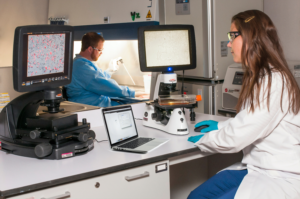
Technology is transforming how healthcare providers prevent, diagnose, and treat disease, how information is shared (and how quickly), and how patient records are analyzed, stored, and managed. Utilizing software applications to automate scientific protocols and collect data in the healthcare and life sciences arena has especially been beneficial in modern times. IT applications have been the backbone of several breakthroughs, without which these scientific efforts would have stagnated, from imaging in medical science to storage and digital curation of data. We glance at the broad areas that Information Technology continues to support in the human quest for a healthier and fast-paced life.
Genomics and “Big Data”
Said, genes are an organism’s functional units that determine how it looks, functions, and lives. Generally, the higher the organism is in the evolutionary tree, it’s genetic data tends to get more complex. Genetic data is not just a simple code that drives a living being; with increasing knowledge of genetics, it is now understood that there are intricate and elaborate mechanisms through which these genes interact with each other and the environment. Although members of any complex species are sufficiently similar, they are yet entirely different from one another. Science today seeks to uncover these differences between individuals for a new understanding of beings and to make any medical treatment more personalized and customized. We are in an age where diseases can be predicted before apparent signs. Treatment options are made to fit each individual for the best outcomes. These are possible with the help of generating a large amount of genetic data from whole populations.
This is possible today in genomics and genetics labs that generate gigabytes of data in a single experiment. It is challenging to analyze such data and have a plausible interpretation unless done on a platform that can process this “big data.” Big Data is also being used to model disease progression, treatment response, and outcomes, apart from being predictors of disease susceptibility. Highly efficient and reliable computer programs are needed to process, analyze, and access this data. Several emerging businesses are now utilizing this opportunity of gathering and analyzing data and providing it to the general public for consumption. Efficient and well-integrated computing tools are needed to deal with unstructured data and issues of data access, curation, transfer, and storage.
Diagnostic Imaging
Science has always depended on imaging to understand the fundamental processes of life. From the era of Leeuwenhoek and Hooke, scientists that visualized cells for the first time several centuries ago, to the present-day visualization of disease states, imaging has come a long way in understanding complex living systems and managing their conditions. Automation and digital integration have made these leaps more rapid and more accessible. Organs are not only visualized in great detail to track the disease states utilizing algorithm-guided image reconstructions, such as with MRI and CT scans, but it is also possible now to image cells and their components, such as proteins and their complexes. Computational methods are now being used to generate high resolution, artifact-free 3D images with a broader field of view that utilize lens-free, on-chip microscopes that can do away with manual focus adjustments. These chip-based microscopes are also easier to use and economically advantageous (1).
Drug Discovery and Pharmaceutical Development
Although medical knowledge has grown by leaps and bounds in the present century, many disorders and diseases still need effective cures and treatments. Even for conditions that already have drug treatments on the market, newer more-effective alternatives are constantly being discovered or tested. However, the costs of time, money and trials on human subjects hinder the discovery process.
Identifying promising compounds even before phase I clinical trials can take up to 6 years for any pharmaceutical lab. Practical computing and simulation tools can cut this time significantly, for example, by predicting ligand-target binding affinities and saving time to generate iterations of the desired compound. (2,3). The power of computing can be tapped further by designing algorithms that can account for more variables while predicting leads for a molecular target, significantly speeding the discovery process and cutting down costs for pharmaceutical companies.
Healthcare and Clinical Trial Data Management
Hospitals and healthcare firms generate large amounts of patient data that need to be accessible by healthcare providers, insurance agents, and patients with the added layer of security and privacy. With the increasing population and expanding healthcare institutes and governmental policies for privacy and accessibility, specialized applications are needed to store and manage such data in a paperless format. With the complex workflow system of modern hospitals, accessing data from different locations requires digitization and integration that modern information technology applications can only bring about. Apart from regular patient data from hospital visits, organizations involved with clinical trials of new drugs and disease treatment protocols also need techniques for monitoring and accumulating new data, which seems burgeoning these days. The number of problems that a typical drug had to undergo doubled between the 1980s and 1990s, while the number of human subjects steadily tripled (4). With the push for newer alternative drugs with higher efficacy and fewer side effects and drugs for previously untreatable conditions, the amount of data that will be generated can only be imagined. Therefore, integrated IT applications will continue to be the platform for organizing and handling such data.
Opportunities for Biotechnology Industry
Biotech companies need efficient resources, equipment, and data management to be viable in the business world. Protocols and products may also fall under regulations for quality, making it imperative to automate monitoring of experimental conditions to ensure consistency in product quality. Further, most procedures integrate the functions of various tools and machines into a final product. For example, a simple flow process for antibiotic production needs a series of variable-controlling instruments for microbial growth and a series of at least two to three varying biochemical purification systems that can remove the biomass and residual contaminants before final processing and quality checks. To make this process faster, economic, convenient, and reliable every time the product is made, there arises a need for an automated and integrated system that can check, track and maintain optimal conditions throughout the process. Therefore, systems integrated with maintenance software are indispensable tools for any productive biotechnological industry.
Information Technology systems are integral to the developing biotech and pharma sectors globally. Automation, Digitization, and Integration of systems and data would continue to be a necessary part of the development and real-world application of scientific knowledge and expand businesses and increase revenues. The convergence of Biotechnology and Information Technology is the best tool at our disposal for excellent outcomes in the healthcare and cutting-edge technology sector.
References:
-
A. Greenbaum, Y. Zhang, A. Feizi, P.-L. Chung, W. Luo, S. R. Kandukuri, and A. Ozcan. (2014), Wide-field computational imaging of pathology slides using lens-free on-chip microscopy. Sci. Transl. Med. 6, 267ra175.
-
Singh J, Chuaqui CE, Boriack-Sjodin PA, et al. (2003), Successful shape-based virtual screening: the discovery of a potent inhibitor of the type I TGFbeta receptor kinase (TbetaRI). Bioorg. Med. Chem. Lett. 13 (24): 4355–9.
-
Becker OM, Dhanoa DS, Marantz Y, et al. (2006), An integrated into silicon 3D model-driven discovery of a novel, potent, and selective amidosulfonamide 5-HT1A agonist (PRX-00023) for the treatment of anxiety and depression. J. Med. Chem. 49 (11): 3116–35.
-
DiMasi, Joseph A., Ronald W. Hansen, and Henry G. Grabowski. (2003). The Price of Innovation: New Estimates of Drug Development Costs. Journal of Health Economics 22: 151–85.










Leave A Comment